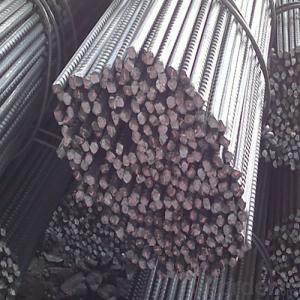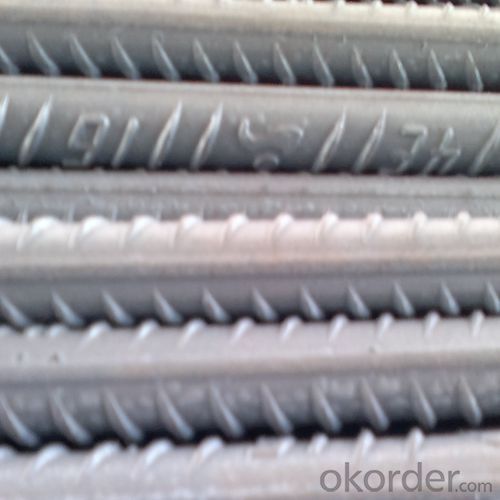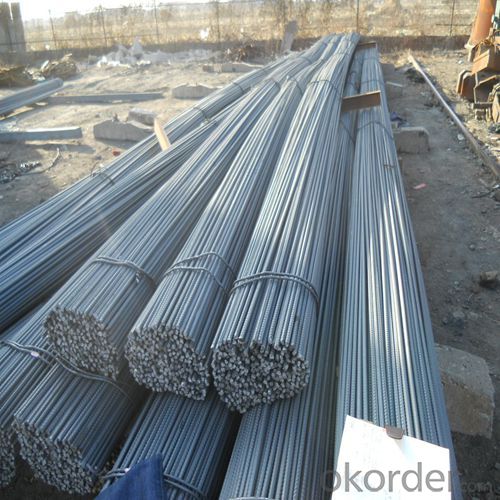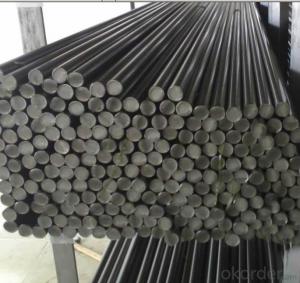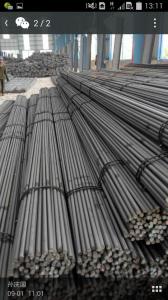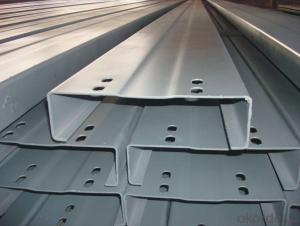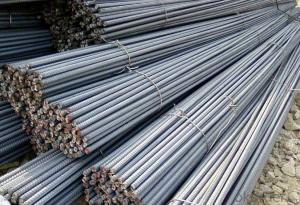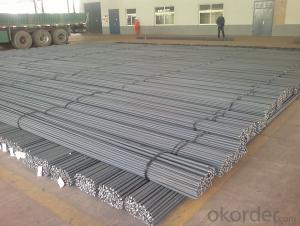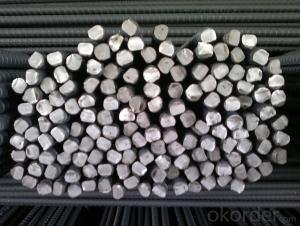HoT Rolled Deformed D-BAR SD400 HRB400
- Loading Port:
- Tianjin
- Payment Terms:
- TT or LC
- Min Order Qty:
- 50 m.t.
- Supply Capability:
- 50000 m.t./month
OKorder Service Pledge
OKorder Financial Service
You Might Also Like
Product Description:
OKorder is offering HoT Rolled Deformed D-BAR SD400 HRB400 at great prices with worldwide shipping. Our supplier is a world-class manufacturer of steel, with our products utilized the world over. OKorder annually supplies products to European, North American and Asian markets. We provide quotations within 24 hours of receiving an inquiry and guarantee competitive prices.
Product Applications:
HoT Rolled Deformed D-BAR SD400 HRB400are ideal for structural applications and are widely used in the construction of buildings and bridges, and the manufacturing, petrochemical, and transportation industries.
Product Advantages:
OKorder's HoT Rolled Deformed D-BAR SD400 HRB400 are durable, strong, and resist corrosion.
Main Product Features:
· Premium quality
· Prompt delivery & seaworthy packing (30 days after receiving deposit)
· Corrosion resistance
· Can be recycled and reused
· Mill test certification
· Professional Service
· Competitive pricing
Product Specifications:
Standard | GB | HRB400 | |
Diameter | 6mm,8mm,10mm,12mm,14mm,16mm,18mm,20mm, 22mm,25mm,28mm,32mm,36mm,40mm,50mm | ||
Length | 6M, 9M,12M or as required | ||
Place of origin | Hebei, China mainland | ||
Advantages | exact size, regular package, chemical and mechanical properties are stable. | ||
Type | Hot rolled deformed steel bar | ||
Brand name | DRAGON | ||
Chemical Composition: (Please kindly find our chemistry of our material based on HRB500 as below for your information)
Grade | Technical data of the original chemical composition (%) | ||||||
C | Mn | Si | S | P | V | ||
HRB400 | ≤0.25 | ≤1.60 | ≤0.80 | ≤0.045 | ≤0.045 | 0.04-0.12 | |
Physical capability | |||||||
Yield Strength (N/cm²) | Tensile Strength (N/cm²) | Elongation (%) | |||||
≥400 | ≥570 | ≥14 | |||||
Theoretical weight and section area of each diameter as below for your information:
Diameter(mm) | Section area (mm²) | Mass(kg/m) | Weight of 12m bar(kg) |
6 | 28.27 | 0.222 | 2.664 |
8 | 50.27 | 0.395 | 4.74 |
10 | 78.54 | 0.617 | 7.404 |
12 | 113.1 | 0.888 | 10.656 |
14 | 153.9 | 1.21 | 14.52 |
16 | 201.1 | 1.58 | 18.96 |
18 | 254.5 | 2.00 | 24 |
20 | 314.2 | 2.47 | 29.64 |
22 | 380.1 | 2.98 | 35.76 |
25 | 490.9 | 3.85 | 46.2 |
28 | 615.8 | 4.83 | 57.96 |
32 | 804.2 | 6.31 | 75.72 |
36 | 1018 | 7.99 | 98.88 |
40 | 1257 | 9.87 | 118.44 |
50 | 1964 | 15.42 | 185.04 |
Usage and Applications of HRB400 Deformed Steel Bar:
Deformed bar is widely used in buildings, bridges, roads and other engineering construction. Big to highways, railways, bridges, culverts, tunnels, public facilities such as flood control, dam, small to housing construction, beam, column, wall and the foundation of the plate, deformed bar is an integral structure material. With the development of world economy and the vigorous development of infrastructure construction, real estate, the demand for deformed bar will be larger and larger..
Packaging & Delivery of HRB400 Deformed Steel Bar:
Packaging Detail: products are packed in bundle and then shipped by container or bulk vessel, deformed bar is usually naked strapping delivery, when storing, please pay attention to moisture proof. The performance of rust will produce adverse effect.
Each bundle weight: 2-3MT, or as required
Payment term: TT or L/C
Delivery Detail: within 45 days after received advanced payment or LC.
Label: to be specified by customer, generally, each bundle has 1-2 labels
Trade terms: FOB, CFR, CIF
FAQ:
Q1: Why buy Materials & Equipment from OKorder.com?
A1: All products offered byOKorder.com are carefully selected from China's most reliable manufacturing enterprises. Through its ISO certifications, OKorder.com adheres to the highest standards and a commitment to supply chain safety and customer satisfaction.
Q2: How do we guarantee the quality of our products?
A2: We have established an advanced quality management system which conducts strict quality tests at every step, from raw materials to the final product. At the same time, we provide extensive follow-up service assurances as required.
Q3: How soon can we receive the product after purchase?
A3: Within three days of placing an order, we will begin production. The specific shipping date is dependent upon international and government factors, but is typically 7 to 10 workdays.
Images:
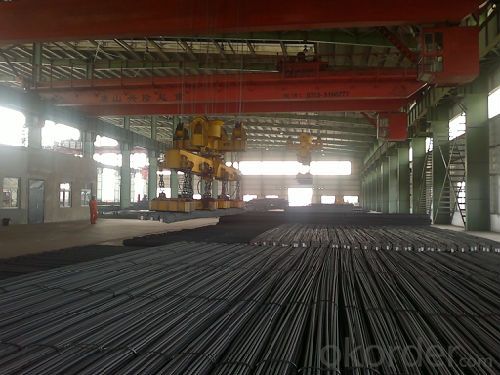
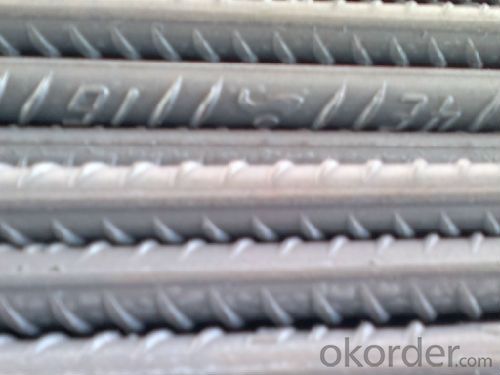
- Q: Can steel rebars be used in bridge deck construction?
- Bridge deck construction can utilize steel rebars. These reinforcement bars, also referred to as rebars, are generally composed of carbon steel and are employed to strengthen concrete structures, including bridge decks. Their application in bridge deck construction is widespread owing to their exceptional tensile strength and capacity to withstand heavy loads. To enhance the strength and prevent cracking, the rebars are positioned within the concrete deck. They function as reinforcements, ensuring even load distribution across the bridge deck, thereby augmenting its load-bearing capability and durability. The resistance of steel rebars to corrosion is crucial in bridge construction due to exposure to adverse environmental conditions such as moisture, salt, and temperature fluctuations. Furthermore, steel rebars offer versatility in design and construction, allowing for easy shaping, bending, and interconnection. This facilitates customized placement and reinforcement of the bridge deck, enabling engineers to optimize the design and meet the required safety and strength standards. In conclusion, steel rebars are a widely adopted and appropriate choice for bridge deck construction due to their impressive strength, resistance to corrosion, and design flexibility. They play a vital role in enhancing the structural integrity and lifespan of bridge decks, making them a reliable and preferred option in bridge construction projects.
- Q: What are the safety precautions when working with steel rebars?
- To minimize the chance of accidents and injuries when working with steel rebars, it is crucial to adhere to various safety measures. Consider the following key precautions: 1. Personal Protective Equipment (PPE): Ensure that you always wear the appropriate PPE, which includes safety glasses or goggles, gloves, steel-toed boots, and a hard hat. This will shield you from potential dangers like falling objects, flying debris, or accidental contact with sharp edges. 2. Training and awareness: Make certain that all workers involved in handling steel rebars receive proper training on safe work practices and are knowledgeable about the potential hazards associated with this work. Regular safety meetings and reminders can help reinforce this knowledge. 3. Proper lifting techniques: Given that steel rebars can be heavy and difficult to handle, employ proper lifting techniques such as bending at the knees and using leg muscles to avoid strains or back injuries. If necessary, utilize mechanical lifting aids like cranes or hoists to lessen the physical strain on workers. 4. Secure storage and handling: Store steel rebars securely and in an organized manner to prevent them from falling or rolling onto workers. When moving or transporting rebars, ensure they are properly secured to prevent shifting or falling during transit. 5. Cutting and bending precautions: When cutting or bending steel rebars, use appropriate tools and equipment like bolt cutters or rebar benders. Always wear protective gloves and ensure that the cutting or bending area is clear of other workers to prevent accidental injuries. 6. Fall protection: When working at elevated heights, such as during the installation of rebars in elevated structures, ensure that proper fall protection measures are in place. This may involve using safety harnesses, guardrails, or safety nets to prevent falls. 7. Fire prevention: Steel rebars can produce sparks when cut or welded, so it is essential to have adequate fire prevention measures in place. Clear the work area of flammable materials, have readily available fire extinguishers, and adhere to appropriate welding safety protocols. 8. Regular equipment maintenance: Keep all tools and equipment used for handling steel rebars well-maintained and in good working condition. Regularly inspect them for any damage or defects that could compromise safety. By adhering to these safety precautions, you can establish a safer working environment when dealing with steel rebars and reduce the risk of accidents or injuries.
- Q: What is the role of steel rebars in bridge construction?
- The role of steel rebars in bridge construction is to provide reinforcement and strength to the concrete structure. Rebars are embedded within the concrete to enhance its ability to withstand tension forces, increase durability, and prevent cracking or failure. They help distribute the load across the bridge, ensuring its stability and longevity.
- Q: What is the role of steel rebars in minimizing the risk of progressive collapse?
- Steel rebars play a crucial role in minimizing the risk of progressive collapse in structures. Progressive collapse refers to the failure of a building or structure due to the localized failure of a primary structural element, which then leads to the failure of adjacent elements and a collapse of the entire structure. The primary function of steel rebars in this context is to enhance the structural integrity and provide strength to critical load-bearing elements, such as columns, beams, and slabs. By reinforcing these elements with steel rebars, the structure becomes more resistant to sudden and catastrophic failures. Steel rebars are typically embedded within the concrete, forming a composite structure known as reinforced concrete. The rebars act as tensile reinforcements, counteracting the concrete's weakness in tension. When subjected to loads, the rebars bear the tension forces while the concrete resists compression forces. This combination allows for a more balanced load distribution and prevents localized failures. In the event of an unexpected failure or an extreme event, such as an explosion or impact, steel rebars play a critical role in preventing progressive collapse. They provide additional ductility and redundancy to the structure, ensuring that even if one element fails, the load can be redistributed to surrounding elements, preventing a domino effect of failure. Moreover, steel rebars contribute to the overall stability of a structure by increasing its load-carrying capacity. By reinforcing structural elements, they allow for increased spans and higher design loads, reducing the risk of overloading and potential failure. Regular inspections and maintenance of steel rebars are essential to ensure their effectiveness in minimizing the risk of progressive collapse. These inspections involve checking for corrosion, proper placement, and adequate cover of the rebars to protect them from environmental factors that may compromise their integrity. In conclusion, steel rebars play a vital role in minimizing the risk of progressive collapse by reinforcing critical load-bearing elements, enhancing structural integrity, and providing redundancy. They enable structures to withstand unexpected failures and extreme events, ensuring the safety and stability of buildings and infrastructure.
- Q: How do steel rebars affect the durability of concrete structures?
- Steel rebars play a crucial role in enhancing the durability of concrete structures. By reinforcing the concrete, rebars help to increase its tensile strength, which is otherwise low compared to its compressive strength. This is crucial because concrete is highly effective in resisting compressive forces, but it is weak in withstanding tension or bending forces. When concrete structures are subjected to external forces like vibrations, wind, or earthquakes, the rebars absorb the tension and bending forces, preventing the concrete from cracking or collapsing. This ensures that the structure remains intact and stable. Without the presence of steel rebars, concrete structures would be more prone to damage and failure under such circumstances. Additionally, steel rebars also enhance the durability of concrete structures by preventing corrosion. When embedded in concrete, rebars act as a protective barrier against moisture and oxygen, which are primary agents that lead to the corrosion of steel. By preventing the penetration of these harmful elements, rebars significantly extend the lifespan of the concrete structure. Moreover, steel rebars provide dimensional stability to concrete structures. As concrete tends to shrink and expand due to temperature changes and moisture variations, the presence of rebars helps to counteract these movements. This prevents cracks from forming and ensures the structural integrity of the concrete. In summary, steel rebars greatly enhance the durability of concrete structures by increasing their tensile strength, preventing cracking and collapse, protecting against corrosion, and providing dimensional stability. Their presence is essential for constructing long-lasting and reliable concrete structures that can withstand various external forces and environmental conditions.
- Q: What are the main characteristics of steel rebars?
- Steel rebars, also known as reinforcing bars, possess several key characteristics that make them an essential component in construction and engineering projects. Firstly, steel rebars exhibit exceptional strength and durability. They are primarily made from carbon steel, which provides high tensile strength, enabling them to withstand heavy loads and stresses without deformation or failure. This strength makes them crucial for reinforcing concrete structures, enhancing their structural integrity and resistance to bending, cracking, and shear forces. Another important characteristic of steel rebars is their corrosion resistance. Since steel can be prone to rusting when exposed to moisture and air, rebars are often coated with epoxy or other protective materials to prevent corrosion. This ensures the longevity and durability of the reinforced concrete structures, making them suitable for various environments, including marine or high humidity areas. Furthermore, steel rebars possess excellent thermal conductivity, allowing them to effectively disperse heat, which is particularly important in structures subjected to extreme temperatures or fire hazards. They also have good bonding properties with concrete due to their ribbed or deformed surface. This textured surface enhances the adhesion between the rebar and the concrete, preventing slippage and providing improved structural stability. Additionally, steel rebars are versatile and can be easily shaped and bent to fit the required design or specifications of a construction project. They are available in various sizes, lengths, and grades, allowing engineers and architects to select the appropriate type of rebar based on the specific load-bearing requirements of the structure. In summary, the main characteristics of steel rebars include their strength, durability, corrosion resistance, thermal conductivity, bonding properties, and versatility. These qualities make steel rebars an essential component in construction, ensuring the safety, stability, and longevity of reinforced concrete structures.
- Q: Can steel rebars be used in structures with high moisture content?
- Steel rebars can be used in structures with high moisture content, but they need to be adequately protected against corrosion. Moisture can accelerate the corrosion process, so proper measures such as using epoxy-coated rebars, providing a sufficient concrete cover, and ensuring effective drainage are necessary to prevent damage to the rebars and maintain the structural integrity of the building.
- Q: What is the typical lifespan of steel rebars in different climates?
- The typical lifespan of steel rebars can vary depending on the climate conditions. In mild climates with low moisture and minimal exposure to corrosive elements, such as saltwater or chemicals, steel rebars can last for several decades or even over a century. However, in more severe climates with high humidity, significant temperature fluctuations, and exposure to corrosive agents, the lifespan of steel rebars may be significantly reduced, ranging from 10 to 50 years. It is important to consider local environmental factors and implement proper maintenance and protection measures to ensure the longevity of steel rebars in different climates.
- Q: What are the main properties of steel rebars?
- Steel rebars, also referred to as reinforcing bars, play a vital role in reinforced concrete structures due to their numerous advantageous characteristics. Firstly, steel rebars possess a high tensile strength, which enables them to withstand substantial pulling forces and effectively reinforce concrete to prevent cracking and structural failure. Secondly, steel rebars exhibit exceptional ductility, meaning they can deform under stress without fracturing. This flexibility allows them to absorb energy during seismic events or extreme loads, enhancing the overall performance and resilience of the reinforced concrete. Moreover, steel rebars are manufactured with a protective layer, such as epoxy or galvanized coating, to ensure corrosion resistance. This property is crucial as exposure to moisture, chloride ions, and other corrosive elements can significantly weaken the rebars and compromise the structural integrity. In addition, steel rebars can be easily welded together, facilitating efficient and effective construction. This feature enables the rebars to be connected seamlessly, forming a continuous and robust reinforcement network that enhances the overall strength and stability of the concrete structure. Furthermore, steel rebars possess thermal compatibility with concrete, meaning they have similar expansion and contraction properties. This characteristic minimizes the risk of cracking or structural damage caused by temperature changes, ensuring the long-term durability and stability of reinforced concrete structures. Lastly, steel rebars are widely available and relatively cost-effective compared to alternative reinforcing materials. This affordability, combined with their exceptional mechanical properties, makes them a popular choice for structural reinforcement in various construction projects. In conclusion, steel rebars offer high tensile strength, ductility, corrosion resistance, weldability, thermal compatibility, and cost-effectiveness. These properties are indispensable for providing structural strength and durability to reinforced concrete structures.
- Q: How do steel rebars affect the overall load distribution of concrete structures?
- Steel rebars significantly affect the overall load distribution of concrete structures by providing tensile strength and reinforcing the concrete. The rebars absorb and distribute the applied load throughout the structure, reducing the risk of cracking and enhancing the structural integrity. Without rebars, concrete structures would be more prone to failure under heavy loads or external forces.
Send your message to us
HoT Rolled Deformed D-BAR SD400 HRB400
- Loading Port:
- Tianjin
- Payment Terms:
- TT or LC
- Min Order Qty:
- 50 m.t.
- Supply Capability:
- 50000 m.t./month
OKorder Service Pledge
OKorder Financial Service
Similar products
Hot products
Hot Searches
Related keywords
